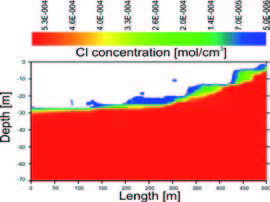Time Scales in the Evolution of Solution Porosity in Porous Coastal Carbonate Aquifers by Mixing Corrosion in the Saltwater-Freshwater Transition Zone
DOI:
https://doi.org/10.3986/ac.v36i1.205Abstract
Dissolution of calcium carbonate in the saltwater-freshwater mixing zone of coastal carbonate aquifers up to now has been treated by coupling geochemical equilibrium codes to a reactive-transport model. The result is a complex nonlinear coupled set of differential transport-advection equations, which need high computational efforts. However, if dissolution rates of calcite are sufficiently fast, such that one can assume the solution to be in equilibrium with respect to calcite a highly simplified modelling approach can be used. To calculate initial changes of porosity in the rock matrix one only needs to solve the advection-transport equation for salinity s in the freshwater lens and its transition zone below the island. Current codes on density driven flow such as SEAWAT can be used. To obtain the dissolution capacity of the mixed saltwater-freshwater solutions the calcium equilibrium concentration ceq(s) is obtained as a function of salinity by PHREEQC-2. Initial porosity changes can then be calculated by a simple analytical expression of the gradient of the spatial distribution s(x, y) of salinity, the distribution of flow fluxes q(x,y) and the second derivative of the calcium equilibrium concentration ceq(s) with respect to salinity s.
This modelling approach is employed to porosity evolution in homogeneous and heterogeneous carbonate islands and coastal aquifers. The geometrical patterns of porosity changes and the reasons of their origin will be discussed in detail. The results reveal initial changes of porosity in the order of several 10-6 per year. This places the time scale of cavern evolution to orders from several tens of thousands to a hundred thousand years.
Downloads

Downloads
Published
How to Cite
Issue
Section
License
Authors guarantee that the work is their own original creation and does not infringe any statutory or common-law copyright or any proprietary right of any third party. In case of claims by third parties, authors commit their self to defend the interests of the publisher, and shall cover any potential costs.
More in: Submission chapter




